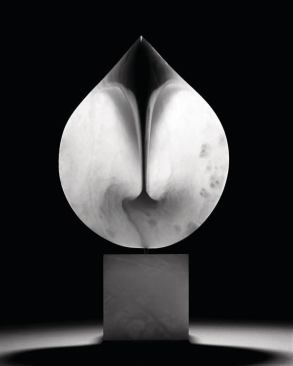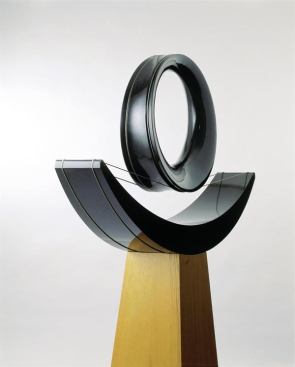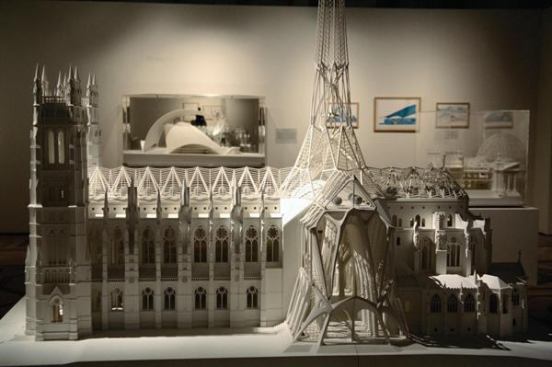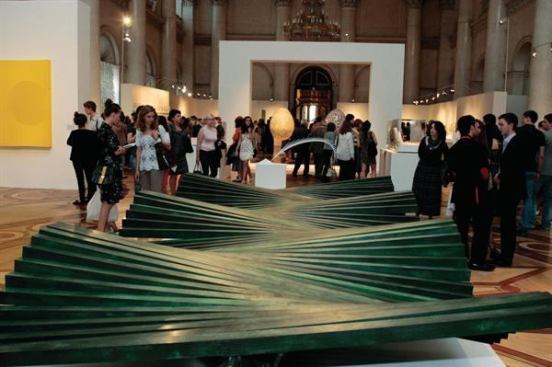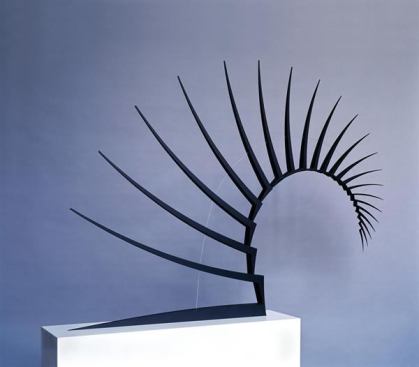Courtesy Santiago Calatrava LLC
“Pure Geometry,” a sculpture from Santiago Calatrava’s exh…
Tenerife Auditorium, designed and constructed between 1991 and 2003 and among Calatrava’s least rational, most organically symbolic works, solicits the same “wow” by different means. Unlike other edifices on display in the exhibit or pictured in the catalog, the Tenerife’s structure is not legible. No cables, columns, or structural networks appear to be visible. The building is composed to express opacity and mass rather than transparency and skeleton. Cantilevering up and curving outwardly over the collage of rounded volumes enclosing the auditorium is an immense, sharply pointed projection. Like a breaking wave, it hovers threateningly over the complex. Or could it be some creature’s claw or fin? What supports it, and why is it there? The Tenerife design, bizarre as it is, does successfully illustrate one aspect of Calatrava’s “quest for movement”: creating visually dynamic forms that don’t actually move.
In addition to movement, there is another visual principle in the Hermitage exhibit that characterizes all of Calatrava’s design work: ornament, and its value in making good architecture. Note that he believes profoundly that expressing a building’s inherent structure and structural components, not applying superficial decoration such as that festooning the Winter Palace, is the way to provide all the necessary ornamentation. This is not a new idea. Historic precedents, such as Greek temples and Gothic cathedrals, as well as any number of modern buildings, show how expressed structure can overtly shape architecture. Calatrava said that Ludwig Mies van der Rohe and Eero Saarinen expressed structural patterns and forms: Mies in composing the curtainwalls of the Seagram Building in New York, Saarinen in shaping the Dulles Airport terminal and Yale University hockey rink.
The Hermitage provides few clues about Calatrava’s method of design. When I asked him to describe his approach to a project, he said he visits the project site and talks extensively with the client. As any good architect does. Then came the answer I sought: Calatrava produces dozens of intuitive gesture sketches—right-brain scribbles and ideograms—made without reference to budgetary objectives or client aspirations. Eventually one appears that captures his fancy, the eureka sketch. Gestating that concept is a job undertaken by his staff, some having been with him for 25 years, who interpret his sketches, nurture the embryonic idea, and generate digital models and drawings that evolve into the final design.
After studying architecture in Spain, Calatrava moved to Zurich, where he earned a Ph.D. in engineering and established his firm. Today his studio and workshop remain in Zurich, although he no longer lives there, for reasons involving a model displayed centrally in the Hermitage exhibit. He and his family reside permanently in New York, allowing him to keep close tabs on his Path Train terminal and transportation center at ground zero. The terminal is still under construction nine years after he designed it. The patience that Calatrava asks of his clients, it would appear, is another of his personal talents.
